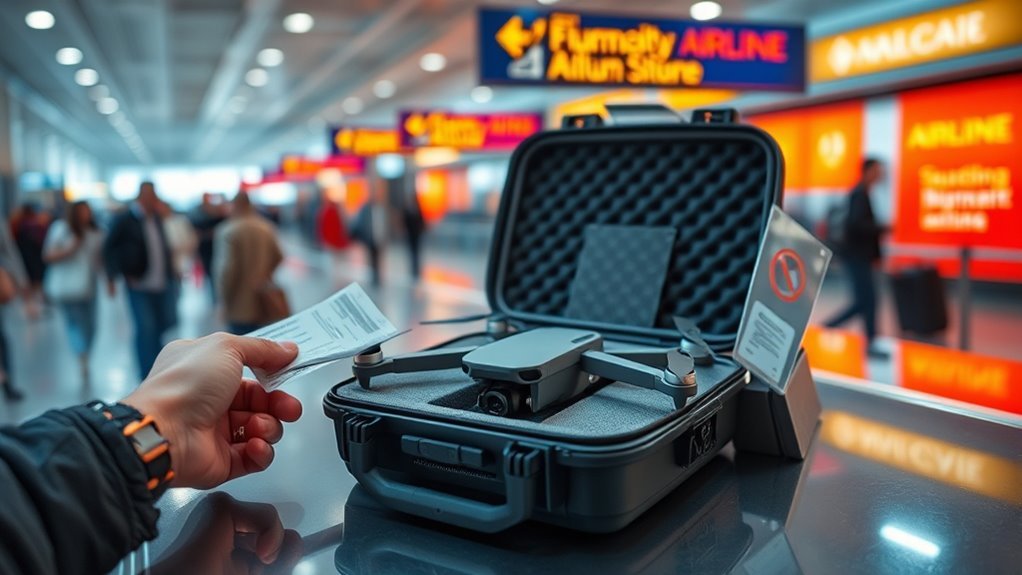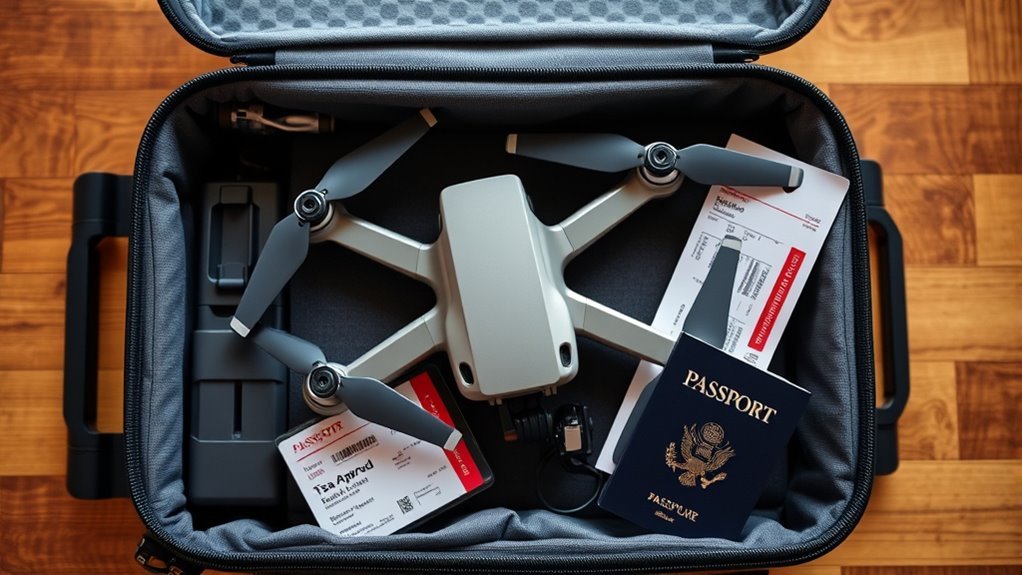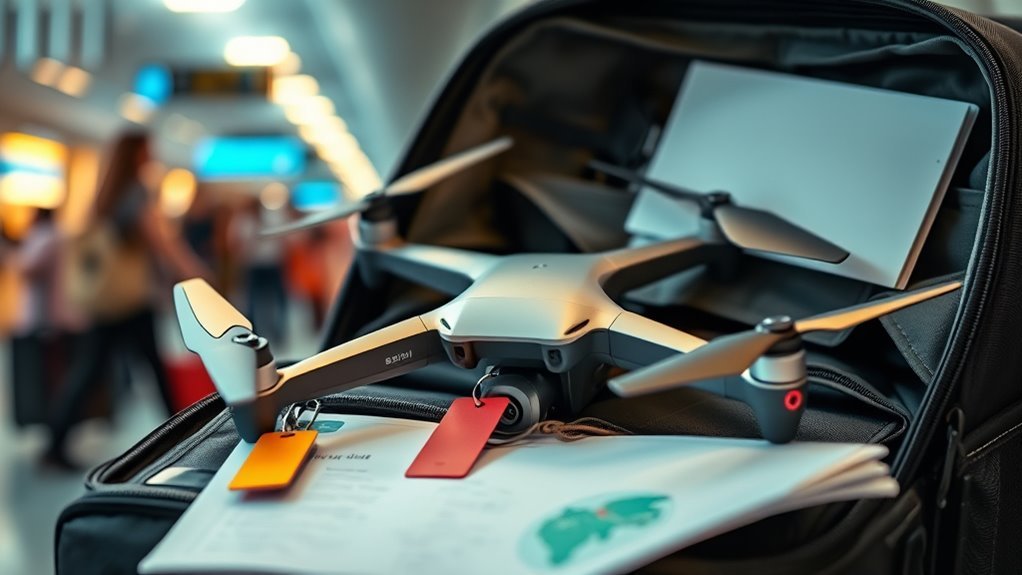To legally take your drone on a plane, you need to follow drone regulations, TSA guidelines, and airline policies. First, register your drone if required, and know the limitations on battery sizes. Pack your drone in carry-on luggage, avoiding checked baggage to prevent damage. Always inform security about your drone and its components. Finally, familiarize yourself with local laws at your destination. If you want more detailed tips on traveling with your drone, keep exploring.
Understanding Drone Regulations

Before you pack your drone for a flight, it’s essential to understand the regulations that govern its transportation. In many countries, drone registration requirements are mandatory. You’ll need to register your drone with the appropriate aviation authority before flying it, guaranteeing compliance with local laws. Additionally, depending on where you plan to fly, you might need drone flying permits, especially in restricted airspaces or when flying commercially. Familiarize yourself with these regulations to avoid fines and guarantee a smooth travel experience. Knowing the rules not only preserves your freedom to fly but also helps maintain safety in the skies. Always check for updates on regulations, as they can change, impacting your flying plans. Moreover, being aware of NDAA compliance is crucial for those flying drones with components from foreign entities, as it can influence your ability to operate legally and safely. Remember that failing to register your drone can lead to significant legal penalties, including fines reaching hundreds or thousands of dollars.
TSA Guidelines for Carrying Drones

When you’re planning to take your drone on a plane, it’s essential to understand the TSA guidelines regarding carry-on and checked baggage. You’ll need to pay special attention to battery regulations and limits, as these can affect how you pack your equipment. Knowing these details can guarantee a smoother travel experience with your drone.
Carry-On vs. Checked Baggage
How can you guarantee your drone travels safely without a hassle? Choosing between carry-on and checked baggage is vital. Opting for carry-on benefits your drone’s safety, as you maintain control and reduce the risk of damage or loss. Keep in mind that most airlines allow drones in carry-on bags, but always check specific policies.
On the other hand, checked baggage can expose your drone to rough handling and extreme temperatures, which could affect its performance. If you have no choice but to check it, make certain it’s well-protected in a sturdy case. Ultimately, for peace of mind and to preserve your freedom to fly, carry your drone on whenever possible.
Battery Regulations and Limits
Traveling with your drone means understanding the battery regulations that come into play. The TSA has specific guidelines regarding battery types and charging limits. Generally, lithium-ion batteries are the most common in drones, and you can bring them on board as carry-on items if they’re under 100 watt-hours (Wh). For batteries between 100 Wh and 160 Wh, you’ll need airline approval. It’s essential to avoid bringing spare batteries in checked baggage due to fire risks. Always keep your batteries in their original packaging or protective cases to prevent short-circuiting. Familiarize yourself with these regulations before your flight to guarantee a hassle-free experience while maintaining your freedom to explore the skies with your drone.
Airline Policies on Drones

Airlines have varying policies regarding the transportation of drones, which can greatly impact your travel plans. Before you head to the airport, check your airline’s specific regulations. Many airlines impose restrictions based on drone size and weight limits, so it’s essential to know your drone’s dimensions and weight. Generally, drones must fit within carry-on guidelines, but some airlines may require them to be checked. Keep in mind that lithium batteries are often subject to additional rules, so verify these details as well. If your drone exceeds weight limits or size restrictions, you may need to reconsider your travel arrangements. Staying informed will help you navigate the complexities of traveling with your drone seamlessly.
Preparing Your Drone for Travel
Before you travel with your drone, you need to check your airline’s regulations to guarantee compliance. Packing your drone safely and securely is essential to prevent damage during transit. Taking these steps will help guarantee a smooth journey for both you and your equipment.
Check Airline Regulations
While you might be enthusiastic to take your drone on your upcoming flight, it’s essential to check the specific regulations set by the airline you’re flying with. Different airlines have varying policies that dictate what drone size is permissible, including weight restrictions and battery regulations. Some airlines may even require you to carry your drone as a carry-on rather than checked luggage. Familiarizing yourself with these airline policies not only guarantees compliance but also avoids potential inconveniences at the airport. Additionally, be prepared to provide documentation or registration details if required. Taking the time to verify these regulations can enhance your travel experience, allowing you the freedom to enjoy your drone adventures without unnecessary complications.
Pack Safely and Securely
After confirming your airline’s regulations, the next step is to pack your drone safely and securely for travel. Invest in a high-quality drone case designed for protection during transit. This will safeguard your equipment from potential damage. Make sure to remove any detachable parts, like propellers and batteries, and store them separately to prevent accidents. Use secure packing materials, such as padding or foam, to fill any gaps in the case, ensuring everything stays in place. If you’re carrying extra batteries, check the airline’s rules on lithium-ion batteries, as there are specific requirements for their transport. By following these steps, you can travel freely with your drone while keeping it safe and compliant with airline guidelines.
Packing Your Drone Safely
When packing your drone for air travel, it’s essential to take a few key steps to guarantee it arrives safely and intact. A little preparation goes a long way, especially when it comes to protecting your investment and ensuring your freedom to fly once you reach your destination.
- Use a sturdy protective case: A high-quality case can absorb shocks and prevent damage during transit.
- Secure your drone accessories: Make sure to pack propellers, batteries, and remote controls in separate compartments to avoid scratches and breaks.
- Label your case: Clearly marking your protective case can help airline staff identify it easily, reducing the risk of loss. Additionally, battery maintenance is crucial to prolonging the lifespan and performance of your drone during travel.
Battery Restrictions and Guidelines
Before you head to the airport, it’s vital to understand the battery restrictions and guidelines that apply to your drone. Most airlines permit lithium polymer (LiPo) and lithium-ion batteries, but there are limits on battery types and capacities. Generally, batteries over 100 watt-hours (Wh) may require special approval, while those exceeding 300 Wh are typically banned. Make certain your batteries are safely stored in protective cases to prevent short circuits or damage during transit. It’s important to carry your batteries in your carry-on luggage, as checked baggage poses significant battery safety risks. Familiarizing yourself with these requirements can help you avoid complications, making your drone adventure remain hassle-free.
International Travel Considerations
When traveling internationally with your drone, you need to be aware of the regulations specific to your destination. Each country has different rules regarding battery restrictions and may require customs declarations. Familiarizing yourself with these considerations will help guarantee a smooth travel experience.
Destination Regulations
While you may be enthusiastic to capture stunning aerial footage during your travels, it’s crucial to familiarize yourself with the regulations governing drone use at your destination. Each country has its own destination laws, and not understanding them can lead to fines or confiscation of your equipment. Here are three key considerations:
- Research Destination Laws: Know if drones are allowed, restricted, or banned in your chosen location.
- Obtain Travel Permits: Some countries require permits for drone use, especially in urban areas or near airports.
- Understand Local Regulations: Familiarize yourself with altitude limits, no-fly zones, and privacy laws to guarantee compliance.
Battery Restrictions
Understanding destination regulations is just the beginning; you’ll also need to navigate battery restrictions when taking your drone on a plane. Different airlines and countries have varying rules regarding battery types, primarily lithium-ion, which are commonly used in drones. Most airlines allow batteries under 100 watt-hours in carry-on luggage, but anything above that usually requires special permission or must be shipped.
Proper battery storage is essential; keep terminals protected to prevent short-circuits. It’s wise to carry your batteries in protective cases or pouches designed for safe transport. Before you fly, always check the specific regulations of your airline and destination to guarantee compliance and avoid any disruptions. Prior preparation will help you maintain your freedom to fly.
Customs Declarations
As you prepare to travel internationally with your drone, it’s essential to be aware of customs declaration requirements that may apply. Not declaring your drone can lead to complications, so make certain you’re informed. Here are three key points to keep in mind:
- Customs Forms: Fill out the appropriate customs forms before arriving at your destination. This guarantees you’re complying with local regulations.
- Duty Fees: Be prepared to pay any duty fees associated with bringing your drone into the country. These fees can vary greatly, so check ahead.
- Documentation: Keep all receipts and documentation handy, as customs officials may request to see proof of purchase or ownership.
Local Laws and Regulations at Your Destination
Before you pack your drone for travel, it’s essential to familiarize yourself with the local laws and regulations of your destination, since these can vary greatly from one place to another. Many countries and regions have specific local drone laws that dictate where and how you can operate your drone. Some areas may require you to register your drone or obtain permits, while others might have restrictions on flying in populated or sensitive areas. Ignoring these regional regulations can lead to hefty fines or confiscation of your equipment. To enjoy your freedom while flying, always check the local rules and guarantee you’re compliant. Doing your research beforehand will help you avoid complications and enhance your travel experience.
Tips for Smooth Security Checks
After verifying you’re compliant with local drone laws, it’s time to prepare for airport security. Smooth security checks are essential for hassle-free travel with your drone. Here are some tips to help you navigate the process:
- Pack Wisely: Keep your drone, batteries, and accessories in an easily accessible carry-on bag. This minimizes delays during screening.
- Be Transparent: Inform security personnel about your drone and its components. This illustrates good drone etiquette and helps them assist you better.
- Check Battery Limits: Familiarize yourself with TSA regulations regarding lithium batteries. Confirm you’re within the allowed limits to avoid complications. Additionally, always remain aware of local regulations that might affect your travel plans.
With proper security preparation and a little awareness, you can maintain your freedom to explore while keeping your drone travels seamless.
Resources for Drone Travelers
When planning your travels with a drone, having the right resources at your fingertips can make all the difference. Start by checking official airline websites for their specific policies regarding drones. Familiarize yourself with drone travel resources like the FAA’s regulations and local laws at your destination. Joining online forums or communities can also provide valuable insights from fellow travelers. Don’t forget to review travel safety guidelines, which can help you navigate security checks and avoid potential pitfalls. Apps designed for drone mapping and weather updates can enhance your flying experience. Additionally, understanding payload management techniques can help you optimize your drone’s performance during travel. Staying informed guarantees you enjoy your freedom to fly while adhering to regulations, making your drone travel both enjoyable and compliant. Additionally, ensure that your drone complies with registration requirements to avoid legal issues during your travels.
Frequently Asked Questions
Can I Use My Drone During the Flight?
You can’t use your drone during the flight due to in-flight regulations. Airlines prohibit drone usage to guarantee safety and compliance. Always check specific airline policies before traveling to avoid any complications.
What Happens if My Drone Is Damaged During Travel?
If your drone’s damaged during travel, consider your drone repair options and check if your travel insurance covers it. Knowing you have support can ease your worries, allowing you to focus on your adventures.
Do I Need Insurance for My Drone While Traveling?
You don’t have to have drone insurance while traveling, but it’s wise. Many travel regulations may not cover damage or loss. Having insurance can protect your investment and provide peace of mind during your journey.
Are There Age Restrictions for Traveling With a Drone?
When you’re soaring high with dreams of adventure, remember drone regulations can vary. Most airlines don’t impose age restrictions, but it’s wise to check travel guidelines to guarantee smooth skies ahead. Stay informed, travel free!
Can I Bring Drone Accessories Like Propellers and Chargers?
You can absolutely bring drone accessories like propellers and chargers. Just remember packing tips and battery regulations; make sure batteries are within limits and properly stored to avoid any issues at security checkpoints.

